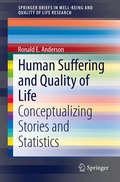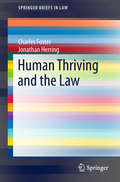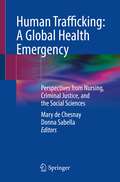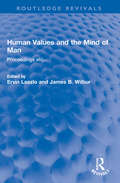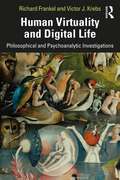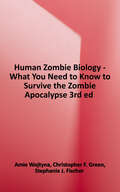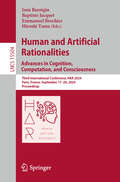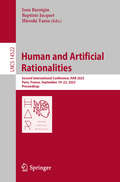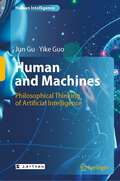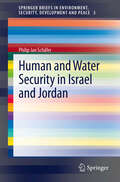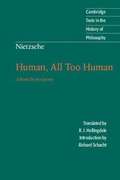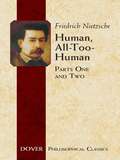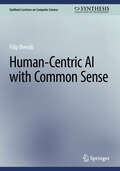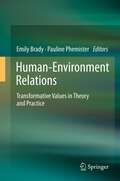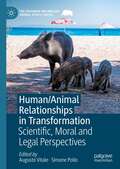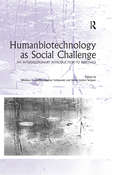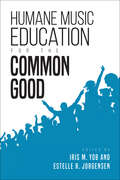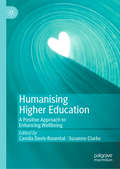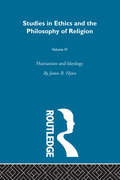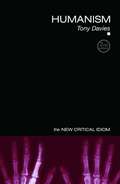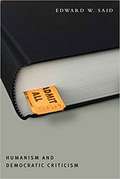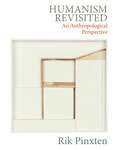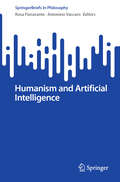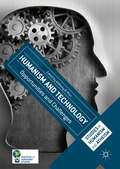- Table View
- List View
Human Suffering and Quality of Life
by Ronald E. AndersonThis briefs on human suffering adds to human understanding of suffering by contextualizing both stories and statistics on suffering, while showing that suffering adds a useful perspective to contemporary thought and research on quality of life, social well-being, and measures of societal progress. The scholarship on suffering is made more comprehensible in the book by using nine different conceptual frames that have been used for making sense of suffering. The primary focus of this work is with the last frame, the quality of life frame. Overall, this chapters show how the research on quality of life and well-being can be enhanced by embracing human suffering.
Human Thriving and the Law (SpringerBriefs in Law)
by Charles Foster Jonathan HerringThe idea of the Good Life – of what constitutes human thriving, is, implicitly, the foundation and justification of the law. The law exists to hold societies together; to hold in tension the rights of individuals as against individuals, the rights of individuals as against various types of non-humans such as corporations (and vice versa), and the rights of individuals individuals as against the state (and vice versa). In democratic states, laws inhibit some freedoms in the name of greater, or more desirable freedoms. The only justification for law is surely that it tends to promote human thriving. But what is the Good Life? What does it mean to live a thriving life? There has been no want of discussion, at least since the great Athenians. But surprisingly, since human thriving is its sole raison d’etre, the law has been slow to contribute to the conversation. This book aims to start and facilitate this conversation. It aims to: -make lawyers ask: ‘What is the law for?’, and conclude that it is to maximise human thriving -make lawyers ask: ‘But what does human thriving mean?’ -make judges and advocates ask: ‘How can a judgment about the best interests of a patient be satisfactory unless its basis is made clear?’
Human Trafficking: Perspectives from Nursing, Criminal Justice, and the Social Sciences
by Donna Sabella Mary De ChesnayThis book presents various forms of human trafficking, a growing trend in the exploitation of large numbers of people with concurrent public health, socio-cultural, and economic costs to countries burdened with the consequences of the COVID-19 pandemic. Edited by psychiatric-mental health nurses and an applied anthropologist, this volume covers all forms of human trafficking: sex trafficking, forced labor, forced marriage, baby trafficking, organ trafficking, child marriage, and child soldiers with a global public health and policy focus. As such, it fills a gap in human trafficking knowledge and is built on courses springing up around the United States in multiple disciplines. Medical, mental health, and social work interventions are included as well as information about programs with documented outcomes. Each chapter includes state of the art of knowledge with case studies illustrating specific focal ideas, discussion, questions and exercises in order to help readers retain and reinforce chapter material. This textbook will be useful in the disciplines of nursing, medicine, public health, social work, and policy making, as well as in disciplines in which human trafficking is a current interest, such as law, criminal justice, and education.
Human Values and the Mind of Man: Proceedings etc... (Routledge Revivals)
by Ervin Laszlo James B. WilburFirst Published in 1971, Human Values and the Mind of Man examines how value questions have been treated in traditional theories of human nature. It discusses the following topics: theory of mind as seen through the rules of the generation of languages; the implications for human value of automata theory; the nervous system, higher mental processes and human values; value consequences of various positions on the mind-body problem; the implications of self-actualization theory for human value; and specific value problems in the philosophy of mind. The book presents an interdisciplinary dialogue centred around thoughts about man and their implications for human action, decision, and nature of what we call the ‘human mind’. This book is an essential read for philosophers, psychologists, scientists, and humanists.
Human Virtuality and Digital Life: Philosophical and Psychoanalytic Investigations
by Richard Frankel Victor J. KrebsThis book is a psychoanalytic and philosophical exploration of how the digital is transforming our perception of the world and our understanding of ourselves. Drawing on examples from everyday life, myth, and popular culture, this book argues that virtual reality is only the latest instantiation of the phenomenon of the virtual, which is intrinsic to human being. It illuminates what is at stake in our understanding of the relationship between the virtual and the real, showing how our present technologies both enhance and diminish our psychological lives. The authors claim that technology is a pharmakon - at the same time both a remedy and a poison - and in their writing exemplify a method that overcomes the polarization that compels us to regard it either as a liberating force or a dangerous threat in human life. The digital revolution challenges us to reckon with the implications of what is being called our posthuman condition, leaving behind our modern conception of the world as constituted by atemporal essences and reconceiving it instead as one of processes and change. The book’s postscript considers the sudden plunge into the virtual effected by the 2020 global pandemic. Accessible and wide-reaching, this book will appeal not only to psychotherapists, psychoanalysts, and philosophers, but anyone interested in the ways virtuality and the digital are transforming our contemporary lives.
Human Zombie Biology: What You Need to Know to Survive the Zombie Apocalypse, Third Edition
by Amie Wojtyna Christopher F. Green Stephanie J. FischerZombies aren’t real. To our knowledge, there are no secret government laboratories working on creating or defeating the zombie menace, but if such laboratories are ever created, then sign us up to be the earth’s last, best hope. Human Zombie Biology provides students the knowledge to gain a greater understanding of the concepts of biology as they apply to zombies. The Centers for Disease Control and Prevention (CDC) has even used zombies to educate the American Public on how to be prepared for any emergency, using the philosophy that if you are prepared for the zombies, you are certainly prepared for whatever Mother Nature may throw at you. It is in this spirit that we offer you this book; what better way to learn the concepts of Biology than by using our friend the zombie? Think you don’t use biology? Think again. Every time you take a deep sniff of air to determine if there is a decaying zombie nearby-- or, slightly more likely, to determine if the old take-out food in the back of your fridge is safe to eat it―then you are using biology. Since people have started talking and then writing about zombies these stories have been a reflection of society, and have drawn upon scientific knowledge to make the stores as realistic as possible. So realistic are these stories that they make for excellent educational tools as they both grab your attention and can impart knowledge. Included with your eBook purchase, you will also receive access to KHQ, Kendall Hunt’s exclusive custom study app. Designed for today’s fast-paced environment, KHQ features chapter quizzes and flashcards that empower students to learn on the go!
Human and Artificial Rationalities. Advances in Cognition, Computation, and Consciousness: Third International Conference, HAR 2024, Paris, France, September 17–20, 2024, Proceedings (Lecture Notes in Computer Science #15504)
by Jean Baratgin Baptiste Jacquet Hiroshi Yama Emmanuel BrochierThis book constitutes the proceedings of the Third International Conference on Human and Artificial Rationalities, HAR 2024, which took place in Paris, France, in September 2024. The 19 full papers and 4 short papers included in this book were carefully reviewed and selected from 52 submissions. They are organized under the following topical sections: Artificial reasoning and models; Moral reasoning; Artificial intelligence and cognition; Rationality and Dual Process; Reasoning and special needs; Education; Experimental procedures in cognition. * This book also contains one additional paper from the HAR 2023 conference.
Human and Artificial Rationalities: Second International Conference, HAR 2023, Paris, France, September 19–22, 2023, Proceedings (Lecture Notes in Computer Science #14522)
by Jean Baratgin Baptiste Jacquet Hiroshi YamaThis book constitutes the proceedings of the Second International Conference on Human and Artificial Rationalities, HAR 2023, which took place in Paris, France, in September 2023. The 18 full and 5 short papers included in this book were carefully reviewed and selected from 39 submissions. They were organized in topical sections as follows: Human and artificial thinking; human thinking and reasoning; neuropsychology and interaction; artificial agents and interaction; and applied reasoning. This volume also contains 2 invited talks in full-paper length.
Human and Machines: Philosophical Thinking of Artificial Intelligence (Human Intelligence)
by Yike Guo Jun GuThis book shares Chinese scholars’ philosophical views on artificial intelligence. The discussions range from the foundations of AI—the Turing test and creation of machine intelligence—to recent applications of AI, including decisions in games, natural languages, pattern recognition, prediction in economic contexts, autonomous behaviors, and collaborative intelligence, with the examples of AlphaGo, Microsoft’s Xiao Bing, medical robots, etc. The book’s closing chapter focuses on Chinese machines and explores questions on the cultural background of artificial intelligence. Given its scope, the book offers a valuable resource for all members of the general public who are interested in the future development of artificial intelligence, especially from the perspective of respected Chinese scholars.
Human and Water Security in Israel and Jordan
by Philip Jan SchäferThe work aims at answering the question as to how far discourses on human security are present in Jordan and Israel, if they converge and if political solutions for the issue of water security could be derived. The analysis is based on the assumption that from human security perspective common solutions for urgent problems can be derived more easily than out of a perspective of national security. Yet it is acknowledged that according to a new security perspective different security threats are being identified by relevant actors. An empirical analysis of written statements and utterances of the respective security elites establishes the methodological tool for the identification of human security discourses in Israel and Jordan. Subsequently it is estimated how far water is presented as a matter of national security in Israel and Jordan using the theory of securitization.
Human, All Too Human: A Book for Free Spirits (Cambridge Texts in the History of Philosophy)
by Friedrich Nietzsche R. J. Hollingdale Karl Ameriks Desmond M. Clarke Richard SchachtThis remarkable collection of almost 1,400 aphorisms was originally published in three instalments. The first (now Volume I) appeared in 1878, just before Nietzsche abandoned academic life, with a first supplement entitled The Assorted Opinions and Maxims following in 1879, and a second entitled The Wanderer and his Shadow a year later. In 1886 Nietzsche republished them together in a two-volume edition, with new prefaces to each volume. Both volumes are presented here in R. J. Hollingdale's distinguished translation (originally published in the series Cambridge Texts in German Philosophy) with a new introduction by Richard Schacht. In this wide-ranging work Nietzsche first employed his celebrated aphoristic style, so perfectly suited to his iconoclastic, penetrating and multi-faceted thought. Many themes of his later work make their initial appearance here, expressed with unforgettable liveliness and subtlety. Human, All Too Human well deserves its subtitle 'A Book for Free Spirits', and its original dedication to Voltaire, whose project of radical enlightenment here found a new champion.
Human, All-Too-Human: Parts One and Two
by Friedrich Nietzsche Helen Zimmern J. M. Kennedy Paul V. Cohn"Offers dazzling observations of human psychology, social interaction, esthetics and religion."--New York Times Book ReviewWith Human, All-Too-Human, Nietzsche challenges the metaphysical and psychological assumptions behind his previous works. The philosopher reviews his usual subjects--morality, religion, government, society--with his characteristic depth of perception, unflinching honesty, and iconoclastic wit. His manner of expression, however, takes a new turn.More than 1,400 incisive and poetic aphorisms appear here. Subtitled "A Book for Free Spirits," this volume marks the author's first use of the aphoristic approach, which he retained in his subsequent writings and elevated to new heights. The style is particularly suited to this book, which rejects overly systematic thinking and conventional wisdom, anticipating both existentialism and post-modernism. Many themes of Nietzsche's later works first appeared here, making Human, All-Too-Human fundamental to an understanding of the author's thought.
Human-Centric AI with Common Sense (Synthesis Lectures on Computer Science)
by Filip IlievskiThis book enables readers to understand the challenges and opportunities of developing human-centered AI with commonsense reasoning abilities. Despite apparent accuracy improvements brought by large neural models across task benchmarks, common sense is still lacking. The lack of common sense affects many tasks, including story understanding, decision-making, and question answering. Commonsense knowledge and reasoning have long been considered the “black matter” of AI, raising concerns about the trustworthiness and applicability of AI methods in both autonomous and hybrid applications. This book describes how to design a more robust, collaborative, explainable, and responsible AI through incorporating neuro-symbolic commonsense reasoning. In addition, the book provides examples of how these properties of AI can facilitate a wide range of social-good applications in digital democracy, traffic monitoring, education, and robotics. What makes commonsense reasoning such a unique and impactful challenge? What can we learn from cognitive research when designing and developing AI systems? How can we approach building responsible, robust, collaborative, and explainable AI with common sense? And finally, what is the impact of this work on human-AI teaming? This book provides an accessible introduction and exploration of these topics.
Human-Environment Relations
by Emily Brady Pauline PhemisterThis fresh and innovative approach to human-environmental relations will revolutionise our understanding of the boundaries between ourselves and the environment we inhabit. The anthology is predicated on the notion that values shift back and forth between humans and the world around them in an ethical communicative zone called 'value-space'. The contributors examine the transformative interplay between external environments and human values, and identify concrete ways in which these norms, residing in and derived from self and society, are projected onto the environment.
Human/Animal Relationships in Transformation: Scientific, Moral and Legal Perspectives (The Palgrave Macmillan Animal Ethics Series)
by Augusto Vitale Simone PolloThe ethics of human/animal relationships is a growing field of academic research and a topic for public discussion and regulatory interventions from law-makers, governments and private institutions. Human/animal relationships are in transformation and understanding the nature of this process is crucial for all those who believe that the enlargement of moral and legal recognition to nonhuman animals is part of contemporary moral and political progress. Understanding the nature of this process means analysing and critically discussing the philosophical, scientific and legal concepts and arguments embedded in it. This book contributes to the discussion by bringing together the ideas and reflections of leading experts from different disciplinary backgrounds and with a range of scientific perspectives.This book both provides an up-to-date examination of the transformation of human/animal relationships and presents ideas to foster this process.
Humanbiotechnology as Social Challenge: An Interdisciplinary Introduction to Bioethics (Ashgate Studies in Applied Ethics)
by Nikolaus Knoepffler Dagmar Schipanski Stefan Lorenz SorgnerHumanbiotechnology has progressed immensely, and humanbiotechnological research has entered a crucial stage. This collection of essays is a significant and original contribution to the public debate on humanbiotechnology and its ethical and social ramifications. Interdisciplinary in composition this volume brings together leading academics in the fields of biology, law, theology, ethics and sociology to share their viewpoints and insights and to promote exchange between disciplines and convey facts and opinions to the wider public on this increasingly important area of technological development and ethical interest. Eschewing analysis on pragmatic or utilitarian grounds the essays in this collection are informed by the key ethical concept of 'human dignity' which has been central to the continental debate on human bioethics and is gaining in importance for the debate in the anglophone world.
Humane Music Education for the Common Good (Counterpoints: Music and Education)
by Iris M. Yob and Estelle R. JorgensenWhy teach music? Who deserves a music education? Can making and learning about music serve the common good? A collection of essays considers the answers.In Humane Music Education for the Common Good, scholars and educators from around the world offer unique responses to the recent UNESCO report titled Rethinking Education: Toward the Common Good. This report suggests how, through purpose, policy, and pedagogy, education can and must respond to the challenges of our day in ways that respect and nurture all members of the human family.The contributors use this report as a framework to explore the implications and complexities that it raises. The book begins with analytical reflections on the report and then explores pedagogical case studies and practical models of music education that address social justice, inclusion, individual nurturance, and active involvement in the greater public welfare. The collection concludes by looking to the future, asking what more should be considered, and exploring how these ideals can be even more fully realized. This volume boldly expands the boundaries of the UNESCO report to reveal new ways to think about, be invested in, and use music education as a center for social change both today and going forward.
Humanesis: Sound and Technological Posthumanism (Posthumanities #25)
by David CecchettoHumanesis critically examines central strains of posthumanism, searching out biases in the ways that human–technology coupling is explained. Specifically, it interrogates three approaches taken by posthumanist discourse: scientific, humanist, and organismic. David Cecchetto&’s investigations reveal how each perspective continues to hold on to elements of the humanist tradition that it is ostensibly mobilized against. His study frontally desublimates the previously unseen presumptions that underlie each of the three thought lines and offers incisive appraisals of the work of three prominent thinkers: Ollivier Dyens, Katherine Hayles, and Mark Hansen. To materially ground the problematic of posthumanism, Humanesis interweaves its theoretical chapters with discussions of artworks. These highlight the topos of sound, demonstrating how aurality might produce new insights in a field that has been dominated by visualization. Cecchetto, a media artist, scrutinizes his own collaborative artistic practice in which he elucidates the variegated causal chains that compose human–technological coupling.Humanesis advances the posthumanist conversation in several important ways. It proposes the term &“technological posthumanism&” to focus on the discourse as it relates to technology without neglecting its other disciplinary histories. It suggests that deconstruction remains relevant to the enterprise, especially with respect to the performative dimension of language. It analyzes artworks not yet considered in the light of posthumanism, with a particular emphasis on the role of aurality. And the form of the text introduces a reflexive component that exemplifies how the dialogue of posthumanism might progress without resorting to the types of unilateral narratives that the book critiques.
Humanising Higher Education: A Positive Approach to Enhancing Wellbeing
by Camila Devis-Rozental Susanne ClarkeThis book explores humanising practice within higher education (HE). It provides a fresh perspective by bringing together expert voices with empirical experience of humanising theory and practice in various areas of higher education, in order to influence and improve the way in which universities work.The book draws on Todres et. al’s humanisation framework, as well other relevant theories such as positive organisational scholarship, Vygotsky’s socio-cultural theory and socio-emotional intelligence. Topics include micro elements of humanisation such as transitions and the student experience, and macro elements such as the policy impact of humanising HE and sustainability. The authors demonstrate how a humanising approach can provide the catalyst for wider change and help to improve wellbeing in the community. This book offers an invaluable resource for scholars interested in teaching and learning in HE, and for HE practitioners and policy makers keen to develop a more human practice.
Humanism & Ideology Vol 4
by James Robert FlynnFirst published in 2003. Routledge is an imprint of Taylor & Francis, an informa company.
Humanism (The New Critical Idiom)
by Tony DaviesDefinitions of humanism have evolved throughout the centuries as the term has been adopted for a variety of purposes – literary, cultural and political – and reactions against humanism have contributed to movements such as postmodernism and anti-humanism. Tony Davies offers a clear introduction to the many uses of this influential yet complex concept and this second edition extends his discussion to include: a comprehensive history of the development of the term and its influences theories of post-humanism, cybernetics and artificial intelligence implications of concepts of humanism and post-humanism on political and religious activism discussion of the key figures in humanist debate from Erasmus and Milton to Chomsky, Heidegger and Foucault a new glossary and further reading section. With clear explanations and poignant discussions, this volume is essential reading for anyone approaching the study of humanism, post-humanism or critical theory.
Humanism And Democratic Criticism (Columbia Themes In Philosophy)
by Edward W. Said Akeel BilgramiIn the radically changed and highly charged political atmosphere that has overtaken the United States―and to varying degrees the rest of the world―since September 11, 2001, the notion that cultures can harmoniously and productively coexist has come to seem like little more than a quaint fiction. In this time of heightened animosity and aggression, have humanistic values and democratic principles become irrelevant? Are they merely utopian fantasies? Or are they now more urgent and necessary than ever before? Ever since the ascendancy of critical theory and multicultural studies in the 1960s and 1970s, traditional humanistic education has been under assault. Often condemned as the intolerant voice of the masculine establishment and regularly associated with Eurocentrism and even imperialism, the once-sacred literary canon is now more likely to be ridiculed than revered. While this seismic shift―brought on by advances in technological communication, intellectual specialization, and cultural sensitivity―has eroded the former primacy of the humanities, Edward Said argues that a more democratic form of humanism―one that aims to incorporate, emancipate, and enlighten―is still possible. A lifelong humanist, Said believed that self-knowledge is the highest form of human achievement and the true goal of humanistic education. But he also believed that self-knowledge is unattainable without an equal degree of self-criticism, or the awareness that comes from studying and experiencing other peoples, traditions, and ideas. Proposing a return to philology and a more expansive literary canon as strategies for revitalizing the humanities, Said contends that words are not merely passive figures but vital agents in historical and political change. Intellectuals must reclaim an active role in public life, but at the same time, insularity and parochialism, as well as the academic trend toward needless jargon and obscurantism, must be combated. The "humanities crisis," according to Said, is based on the misperception that there is an inexorable conflict between established traditions and our increasingly complex and diversified world. Yet this position fails to recognize that the canonized thinkers of today were the revolutionaries of yesterday and that the nature of human progress is to question, upset, and reform. By considering the emerging social responsibilities of writers and intellectuals in an ever more interdependent world and exploring the enduring influence of Eric Auerbach's critical masterpiece, Mimesis, Said not only makes a persuasive case for humanistic education but provides his own captivating and deeply personal perspective on our shared intellectual heritage.
Humanism Revisited: An Anthropological Perspective
by Rik PinxtenThe West emancipated itself from the old humanism long ago and in doing so distanced itself from ‘heteronomy’: it declared that man, and not a non-human power, should be the first reference to approach people and nature. Today, as heirs of this tradition, we are still stuck in Eurocentrism (and often racism), and now even threaten to ruin nature by destroying biodiversity and causing the climate to warm up dangerously. Applied through an anthropological perspective, this book calls for a NEED-humanism: Not-Eurocentric, Ecological and (economically) Durable approach that can help promote inclusion and pluralism.
Humanism and Artificial Intelligence (SpringerBriefs in Philosophy)
by Antonino Vaccaro Rosa FioravanteThis book contributes to the debate on humanism in AI by providing a, so far lacking, comprehensive account of the significant challenges posed by AI to organizations from a humanistic perspective. It does so in two ways: by discussing ethical challenges of AI using humanistic assumptions, normative implications, and underpinning theoretical stances and by focusing on those challenges that can be considered well suited to be tackled from a humanistic perspective as they are more urgent for humanistic-led organizations, as well as those willing to become so. This new perspective allows for new and important discussions, making the book an important read for philosophers of technology and AI.
Humanism and Technology
by Anthony B. PinnThis book interrogates the ways in which new technological advances impact the thought and practices of humanism. Chapters investigate the social, political, and cultural implications of the creation and use of advanced forms of technology, examining both defining benefits and potential dangers. Contributors also discuss technology's relationship to and impact on the shifting definitions we hold for humankind. International and multi-disciplinary in nature and scope, the volume presents an exploration of humanism and technology that is both racially diverse and gender sensitive. With great depth and self-awareness, contributors offer suggestions for how humanists and humanist organizations might think about and relate to technology in a rapidly changing world. More broadly, the book offers a critical humanistic interrogation of the concept of "progress" especially as it relates to technological advancement.
